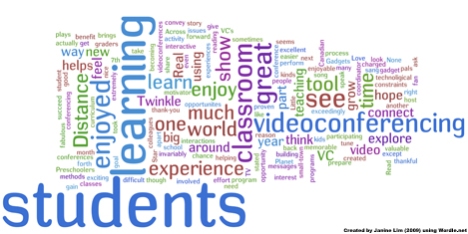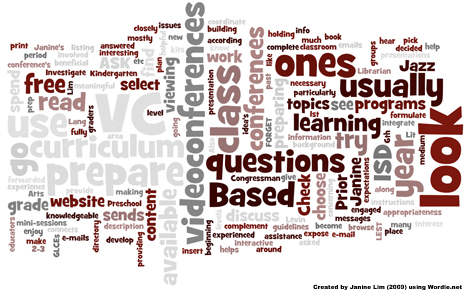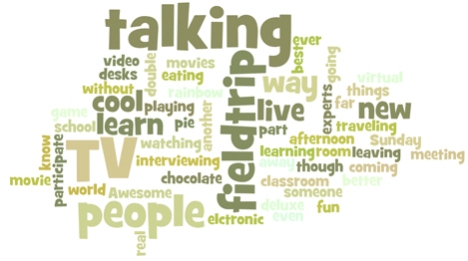This post is part of a series of posts with some of the results from a survey of my top VC-using teachers. Read more about it in the first post of this series. Remember, they are using videoconferencing to support curriculum instruction (not full length courses).
The question featured in this post is the last question in the survey:
Any Other Comments You Want to Share?
This is a qualitative representation of the results using Wordle. Click the graphic for a larger version.
Students and learning are front and center. Are you surprised? Here are some more comments:
This is a song we sang at our Read Across the Planet (to the tune of Twinkle Twinkle Little Star) Distance learning is a fabulous experience & I’m exceedingly thankful that I can give my kids the chance to be a part of it!
We hope you’ve enjoyed our show
Distance learning helps us grow
We learn to speak and to perform
We get to explore explore
We hope you’ve enjoyed our show
Distance learning helps us grow. – Heidi Clark, 1st grade teacher at Three Oaks Elementary, River Valley.We enjoy the videoconferences and I feel that my students learn about themselves, the curriculum, and the world around them while participating. –Wendy Zahrn, 4th grade, Sylvester Elementary, Berrien Springs
This has been an exciting opportunity for our Preschoolers and created new methods of learning and teaching. –Esther Nixon, Preschool, Mars Elementary, Berrien Springs
The students gain so much from a VC that they are worth the time and effort involved. -Karen Ennesser, 7th grade science, Dowagiac Middle School, Dowagiac
My goal is to have videoconferencing right in my classroom. –Linda McConville, 4th grade, E. P. Clarke Elementary, St. Joseph
Videoconferencing is much easier than many think it to be. It is an excellent tool to share with your students. Real world/life plays a big part in this process. We are becoming a technological world and students will need these kinds of experiences to succeed. -Dori Hughes, 2nd grade, Eagle Lake Elementary, Edwardsburg
One of the 7th graders stated that the video conference was the most memorable activity for this school year. Students are “charged” to learn in this way. It’s a great tool to connect small-town students to the world around them. -Peggy Clore, 5-7th language arts, Coloma Middle School, Coloma
I am a big fan of videoconferencing because of the interactions of host and classroom. -Barb Vegter, 3rd grade, Countryside Charter
Videoconferencing has proven to be a great motivator of student interest. They enjoy the experience and invariably ask when we’ll do another. –Anonymous high school teacher
Reflecting on the process:
Did you get any ideas for your future program evaluations? I’m thinking that some of these questions could be easily made into a multiple choice to get more quantitative data to compare from year to year. I’m thinking I would also like to survey my teachers who have done a VC before, but didn’t do one this year. This could be very valuable data as well.
Did you find this little series helpful? What did you learn? Click comment below to share your thoughts.






